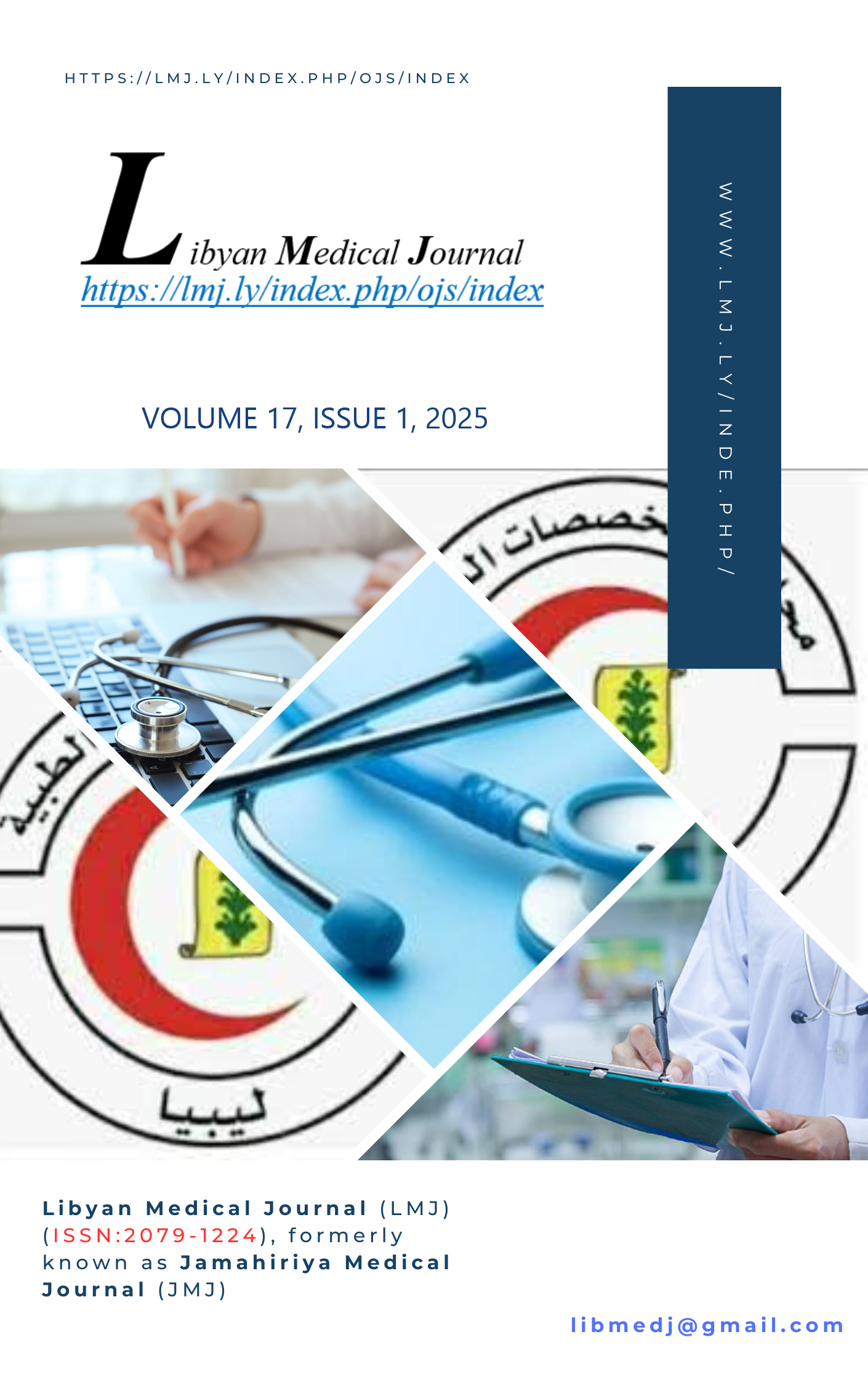Secondary Hypertension in the Libyan population: A Descriptive Analysis of Underlying Causes and Patient Outcomes
DOI:
https://doi.org/10.69667/lmj.2517111Keywords:
Blood pressure, Secondary hypertension, Renal disease, HypothyroidismAbstract
Hypertension is the predominant modifiable risk factor for all-cause morbidity and mortality worldwide. Approximately 10% of hypertension patients have secondary causes that can be treated. This study aims to describe the causes, presenting symptoms and clinical outcomes of secondary hypertension patients attending the hypertension clinic at Tripoli University Hospital (TUH). This was a retrospective descriptive analysis of data collected from all adult patients with secondary hypertension followed up at the hypertensive clinic at TUH from 01/01/2020 to 31/12/2024. Secondary hypertension was defined as “elevated blood pressure, which is secondary to an identifiable cause. There were 82 secondary hypertension patients. There were 32 males (39%) and 50 females (60%), with a mean age of 45 years (range: 19–73 years). Secondary hypertension caused by renal disease ranked first and accounted for almost 44% of cases. This is followed by hypothyroidism and obstructive sleep apnoea syndrome rates of approximately 15% and 10%, respectively. Among the 26 patients with endocrine causes, 20 (77%) were women. While 5 (62%) of the 8 obstructive sleep apnoea syndrome patients were men, 44 (53.6%) of the total number of study patients had improved or reversed blood pressure after treatment for the underlying cause. Renal diseases are the most common cause of secondary hypertension. Secondary causes of hypertension are common and, in certain instances, potentially reversible. It is recommended that hypertensive patients be screened for secondary hypertension and that the underlying condition be addressed to mitigate the risk of cardiovascular complications.
ارتفاع ضغط الدم هو عامل الخطر السائد القابل للتعديل لجميع أسباب المرض والوفيات في جميع أنحاء العالم. يعاني حوالي 10٪ من مرضى ارتفاع ضغط الدم من أسباب ثانوية يمكن علاجها. تهدف هذه الدراسة إلى وصف الأسباب والأعراض الحالية والنتائج السريرية لمرضى ارتفاع ضغط الدم الثانوي الذين يرتادون عيادة ارتفاع ضغط الدم في مستشفى طرابلس الجامعي. كان هذا تحليلًا وصفيًا بأثر رجعي للبيانات التي تم جمعها من جميع المرضى البالغين المصابين بارتفاع ضغط الدم الثانوي الذين تمت متابعتهم في عيادة ارتفاع ضغط الدم في مستشفى طرابلس الجامعي من 01/01/2020 إلى 31/12/2024. تم تعريف ارتفاع ضغط الدم الثانوي بأنه "ارتفاع ضغط الدم الثانوي لسبب يمكن تحديده". كان هناك 82 مريضًا بارتفاع ضغط الدم الثانوي. كان هناك 32 ذكرًا (39٪) و 50 أنثى (60٪)، بمتوسط عمر 45 عامًا (المدى: 19-73 عامًا). احتل ارتفاع ضغط الدم الثانوي الناجم عن أمراض الكلى المرتبة الأولى وشكل ما يقرب من 44٪ من الحالات. ويلي ذلك معدلات قصور الغدة الدرقية ومتلازمة انقطاع النفس الانسدادي أثناء النوم بنحو 15% و10% على التوالي. ومن بين 26 مريضًا يعانون من أسباب الغدد الصماء، كان 20 (77%) من النساء. وفي حين كان 5 (62%) من مرضى متلازمة انقطاع النفس الانسدادي أثناء النوم الثمانية من الرجال، تحسن ضغط الدم أو انعكس لدى 44 (53.6%) من إجمالي عدد مرضى الدراسة بعد العلاج من السبب الأساسي. وتعد أمراض الكلى السبب الأكثر شيوعًا لارتفاع ضغط الدم الثانوي. والأسباب الثانوية لارتفاع ضغط الدم شائعة، وفي بعض الحالات، يمكن عكسها. ويوصى بفحص مرضى ارتفاع ضغط الدم بحثًا عن ارتفاع ضغط الدم الثانوي ومعالجة الحالة الأساسية للتخفيف من خطر حدوث مضاعفات القلب والأوعية الدموية
References
Egwumah O, Girgih A, Joshua V. Managing Hypertension: The Role of a Food Scientist and Nutritionist. AlQalam Journal of Medical and Applied Sciences. 2022 Jul 8:353-67.
Faselis C, Doumas M, Papadopoulos DP, Kokkinos P. Secondary hypertension: to screen or not to screen? Am J Hypertens. 2011;24(7):717-718.
Odewusi O, Uzowa C, Adetunji F, Olaniyan O, Obadire O, Sokunbi Z. An Assessment of the Relationship Between Essential Hypertension with Nfkb Transcription Factor and Antioxidant Parameters. AlQalam Journal of Medical and Applied Sciences. 2023 May 26:246-54.
Elmaghour AA, Labeeb SA, Abdelgawad MA, Dewidar HM. Prevalence of hypertension and its associated risk factors among adults in Al-Marj City, Libya. J High Blood Press Cardiovasc Prev. 2020;27(3):217-223.
Benali R, Khalfallah A, Bougmiza I, Khlifi S, Abdelmoumen A, Achour N. Prevalence of hypertension and associated risk factors in the adult population of Tripoli, Libya. J Epidemiol Glob Health. 2018;8(1-2):52-57.
Williams B, Mancia G, Spiering W, Agabiti Rosei E, Azizi M, Burnier M, et al. ESC Scientific Document Group. 2018 ESC/ESH Guidelines for the management of arterial hypertension. Eur Heart J. 2018;39(33):3021-3104.
Puar TH, Mok Y, Debajyoti R, Khoo J, How CH, Ng AK. Secondary hypertension in adults. Singapore Med J. 2016;57(5):228-32.
Charles L, Triscott J, Dobbs B. Secondary Hypertension: Discovering the Underlying Cause. Am Fam Physician. 2017;96(7):453-461.
Libyan Ministry of Health. (2009). STEPwise approach to surveillance (STEPS) survey 2009: Noncommunicable diseases and risk factors: Libya. Retrieved from [https://extranet.who.int/ncdsmicrodata/index.php/catalogue/248]. Accessed 01/09/2024
Alsla M A, Yahya R A, Azab A E. Burden of Non Communicable Diseases Risk Factors in Libya and other Arabic Countries: Step Wise Survey Comparative Analysis. IJAHMR. 2024;8(4), 206-213.
Almeida MQ, Silva GV, Drager LF. What Is the Most Common Cause of Secondary Hypertension?: An Interdisciplinary Discussion. Curr Hypertens Rep. 2020;22(12):101.
Börgel J, Springer S, Ghafoor J, Arndt D, Duchna HW, Barthel A, et al. Unrecognised secondary causes of hypertension in patients with hypertensive urgency/emergency: prevalence and coprevalence. Clin Res Cardiol. 2010;99(8):499-506.
Omura M, Saito J, Yamaguchi K, Kakuta Y, Nishikawa T. Prospective study on the prevalence of secondary hypertension among hypertensive patients visiting a general outpatient clinic in Japan. Hypertens Res 2004;27:193–202.
Mosso L, Carvajal C, González A, Barraza A, Avila F, Montero J, et al. Primary aldosteronism and hypertensive disease. Hypertension. 2003;42(2):161-5.
Calhoun DA, Jones D, Textor S, Goff DC, Murphy TP, Toto RD, et al. American Heart Association Professional Education Committee. Resistant hypertension: diagnosis, evaluation, and treatment: a scientific statement from the American Heart Association Professional Education Committee of the Council for High Blood Pressure Research. Circulation. 2008;117(25):e510-26.
Pedrosa RP, Drager LF, Gonzaga CC, Sousa MG, de Paula LK, Amaro AC, et al. Obstructive sleep apnea: the most common secondary cause of hypertension associated with resistant hypertension. Hypertension. 2011;58(5):811-7.











